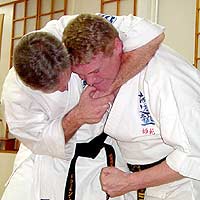Defeating The Headlock
Part 2 - Against A Headlock Already In Place
by Christopher Caile

Editor's Note: This is the second of a two
part article on how to defend against headlocks. The first
article discussed how to escape from a headlock that
was just developing. This second article addresses how to escape from
a headlock that is already secured, as well as how to deal with someone
who is just playing. Other, optional techniques are also discussed.
Some of the techniques shown in these two articles are very dangerous.
Always practice carefully so not to injure your partner. Also be sure
to practice under the guidance and supervision of a trained expert and
teacher.
The Tight Headlock
The following technique is a natural continuation of the technique
shown in the first article. If the first technique doesn't work, or
your attempt to grab the opponent's forearm comes too late, this secondary
technique can be effective.
Sometimes, however, people are surprised and find themselves suddenly
in a tight headlock. It all happens so fast that there is no time to
avoid the headlock in its initiation stage. Fortunately, it is not too
late to escape. The technique below (and its variations) are all that
is needed.
In this technique, reminiscent of a movement found in many karate kata,
the defender moves his inside arm (the one facing the attacker) back
and over the top between his head and the opponent's head -- the hand
grabbing the attacker's hair, nose, or in this illustration, the chin
using the thumb. To make the chin technique effective, the thumb must
be bent (it looks like a fish hook), so it can hook under the chin bone
(mandible), just before the angle of the jaw.
The tip of the thumb is pulled up into the nerve that runs up along
the inside jaw line. (1) This can be very
painful and is used to pry the head backward. At the same time the defender's
outside arm hooks under the attacker's front knee and pulls the leg
upward.
When done together, the two arm techniques pull the opponent backward
and off balance (left). For comparison, a kata movement is also illustrated.
Notice, however, that in kata, the technique is illustrated at the position
of engagement (just initiating the counter) and not at its ending point,
which is more extended.
This technique alone, however, doesn't always work. If the attacker
is very determined and/or ignores the pain, the fishhook thumb nerve
attack, hair grab or other technique used to pull the head back can
be ineffective. So, now what?
(Continued
next page)
Footnote:
(1) From a neurological viewpoint you are attacking
the hypoglossal nerve at approximately an inch forward from the angle
of the jaw (before the jaw turns upward toward the ear). This is where
the nerve connects to the back end of the tongue. The best way to activate
this point is quickly to penetrate with the thumb tip upward toward
the top of the skull. When done properly the technique can cause acute
pain and momentarily stun the opponent.